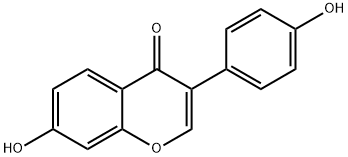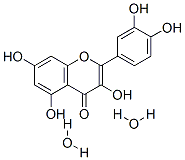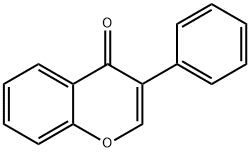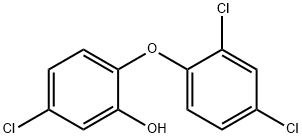Daidzein
Synonym(s):Daidzein;Isoaurostatin;4?,7-Dihydroxyisoflavone, Casein Kinase II Inhibitor X;4′,7-Dihydroxy-iso-flavone;7-Hydroxy-3-(4-hydroxy-phenyl)-4H-1-benzo-pyran-4-one
- CAS NO.:486-66-8
- Empirical Formula: C15H10O4
- Molecular Weight: 254.24
- MDL number: MFCD00016954
- EINECS: 207-635-4
- SAFETY DATA SHEET (SDS)
- Update Date: 2024-12-18 14:08:57

What is Daidzein?
Description
Daidzein mainly comes from leguminous plants, the seeds of soybean (dadou), red clover grass, or all Pueraria roots. Its medicinal value was first recorded in Shen Nong Ben Cao Jing 2838 BC.?Daidzein, one of the main soy isoflavones, is also the main component of radix puerariae (Gegen) which is the dry root of kudzu leguminous plants. Radix puerariae can reduce fever, produce saliva, and relieve diarrhea. Its chemical composition is complicated, including puerarin, xyloside, soy flavonoids, soybean flavonoid glycosides, beta-sitosterol, daidzin, daidzein. The main effective components are puerarin and daidzein
Description
Daidzein is an isoflavone phytoestrogenic compound that has been found in soybeans and other legumes. It binds to estrogen receptor β (ERβ; Ki = 2.8 μM) but not ERα at concentrations up to 1 mM. It is estrogenic in vitro, increasing gene transcription mediated by the estrogen response element (ERE) in a reporter assay in an ERβ-dependent manner (EC50 = 2.8 μM for MCF-7 cells expressing ERβ). Daidzein is an inhibitor of carbonic anhydrase (CA) that is selective for carbonic CAVII and CAXII (Kis = 4.2 and 56 nM, respectively) over CAI, II, and IV (Kis = >10,000, >10,000, and 718.7 nM, respectively). It reduces tumor growth in a PC3 prostate cancer mouse orthotopic model when administered at a dose of 50 mg/kg per day and potentiates the effects of radiation therapy.
Chemical properties
Off-White Crystalline Solid
Physical properties
Appearance: pale-yellow prismatic crystal. Melting point: 315–323?°C. Solubility: soluble in ethanol and ether
History
Daidzein is a kind of isoflavone compound, which was first synthetized by researchers in China. It has been widely used in drugs, food supplements, and cosmetics.
Because of two phenolic hydroxyl structures, Daidzein has poor water solubility,
poor liposolubility, and strong first-pass effect, leading to the low bioavailability of
oral absorption, which limits its widely clinical usage.
Ipriflavone is a kind of isoflavone modified from Daidzein, which has been used
for the treatment of osteoporosis in Japan and some European countries. The effects
of a series of amino alkoxy derivatives of ipriflavones on inhibiting the bone absorption were evaluated. The researchers found that 7-amino alkoxy derivative works
best. When Daidzein was alkylated or acylated at 7-hydroxyl selectively, the stability was increased, and thus the proliferation of MCF-7 cell was inhibited.
The Uses of Daidzein
Inactive analog of Genistein (Cat. #G350000). Blocks the G1 phase of the cell cycle in Swiss 3T3 cells by inhibiting casein kinase II activity1. Daidzein has also been shown to inhibit the action of GABA on recombinant GABAA receptors2. uv max:250 nm (log e 4.44)
The Uses of Daidzein
Daidzein belongs to the group of isoflavones. Daidzein and other isoflavone compounds, such as genistein, are present in a number of plants and herbs. Soy isoflavones are a group of compounds found in and isolated from the soybean. Besides functioning as
The Uses of Daidzein
phytoestrogen
What are the applications of Application
Daidzein is an inactive analog of genistein, a tyrosine kinase inhibitor and an estrogen receptor activator
Definition
ChEBI: A member of the class of 7-hydroxyisoflavones that is 7-hydroxyisoflavone substituted by an additional hydroxy group at position 4'.
Indications
Daidzein is mainly used for the treatment of hypertension, coronary heart disease, cerebral thrombosis, and vertigo and aids in the treatment of sudden deafness. It can also treat women with menopause syndrome.
General Description
Daidzein is an endocrine-active estrogenic isoflavone. This phytoestrogen is capable to bind to estrogen to exert estrogenic effects in vivo. It can naturally be found in soybean seed and flour.
Biological Activity
Analog of the phytoestrogen genistein (5,7-Dihydroxy-3-(4-hydroxyphenyl)-4H-1-benzopyran-4-one ). Blocks G 1 phase cell cycle progression and is an agonist at estrogen receptors.
Biochem/physiol Actions
Soy isoflavone daidzein protects against oxidative damage in liver cells induced by 7,12-dimethylbenz[a]anthracene (DMBA). Catalase and superoxide dismutase activity, down-regulated by DMBA, was restored by daidzein.
Pharmacology
Daidzein has many kinds of pharmacological effects, such as anticancer, cardiovascular protection, estrogen- and antiestrogen-like effects, antiosteoporosis, antioxidation, improving immunity, and affecting the endocrine system. More attention has
been paid by domestic and international pharmaceutical and food industries.
Daidzein has obviously antibacterial effect on Staphylococcus aureus and Escherichia
coli. It can also increase the weight of immune organs in mice and has anti-arrhythmic effect. The chemical structure of daidzein is very similar to the endogenous
estrogen, so the estrogen-like effect is used to treat menopausal syndrome and
increase the levels of osteocalcin (BGP) and also the bone mineral deposits. The
clinical efficacy is similar to estrogen replacement therapy (ERT). Daidzein doesn’t
induce the high expression of estrogen. It has effects on the osteoblast to reduce the
bone absorption of osteoclast, thus maintains the dynamic balance of osteoblast and
osteoclast, finally reduces the risk of fracture. So it is safe for usage. Daidzein can
also increase the bone mineral density (BMD) and bone mineral content (BMC) of
the lumbar spine, the number of trabecular bone, and bone volume fraction, improve
the bone microstructure, and thus prevent the reduction of femur biomechanics in
glucocorticoid-induced osteoporosis in the rat.
Daidzein has an anti-hypoxia effect. The study showed that Daidzein could significantly prolong the survival time of mice in hypoxia tolerance test under normal pressure
and after subcutaneous injection of isoproterenol, suggesting that Daidzein has the significant anti-hypoxia effects. Daidzein plays a protective role in myocardial hypertrophy induced by isoproterenol in rat probably by the antioxidative effects. Similarly,
Daidzein may protect the ischemia-reperfusion injury in rats by increasing the antioxidative capacity. Daidzein can significantly inhibit the proliferation of two human breast
cancer cells (MCF-7 and MDA-MB-231) in?vitro with the significant dose-dependent
and time-dependent effects. Daidzein can markedly decrease the colony-forming ability,
suggesting that Daidzein may have the effect of preventing and treating breast cancer.
It was found that Daidzein has the obviously preventive effect on chloroforminduced ventricular fibrillation in mice, therapeutic effect on aconitine-induced
arrhythmia in rats, as well as protective effect on the adrenaline-induced arrhythmia
in rabbit. Daidzein can significantly reduce the action potential amplitude of sciatic
nerve in toad in?vitro. All of the above effects were obviously dose-dependent, suggesting Daidzein has the significant anti-arrhythmic effects
Clinical Use
Daidzein can expand the coronary artery, femoral artery, and cerebral artery, increase cerebral blood flow and limb blood circulation, reduce blood viscosity and vascular resistance, decrease myocardial oxygen consumption, improve heartfunction, increase the microcirculation and blood flow to the tip, lower the blood pressure, and adjust the heart rhythm. Daidzein can be used for the treatment of hypertension, coronary heart disease, angina pectoris, myocardial infarction, cerebral thrombosis, dizziness, and sudden deafness. It can also be used for women’s menopause syndrome.
storage
-20°C (desiccate)
Properties of Daidzein
| Melting point: | 315-323°C (dec.) |
| Boiling point: | 317.45°C (rough estimate) |
| Density | 1.1629 (rough estimate) |
| refractive index | 1.4300 (estimate) |
| storage temp. | 2-8°C |
| solubility | DMSO: 10 mg/mL |
| form | Powder |
| pka | 7.01±0.20(Predicted) |
| color | White to off-white |
| Water Solubility | insoluble |
| Merck | 14,2801 |
| BRN | 231523 |
| CAS DataBase Reference | 486-66-8(CAS DataBase Reference) |
| EPA Substance Registry System | 4H-1-Benzopyran-4-one, 7-hydroxy-3-(4-hydroxyphenyl)- (486-66-8) |
Safety information for Daidzein
| Signal word | Warning |
| Pictogram(s) |
 Exclamation Mark Irritant GHS07 |
| GHS Hazard Statements |
H315:Skin corrosion/irritation H319:Serious eye damage/eye irritation |
| Precautionary Statement Codes |
P264:Wash hands thoroughly after handling. P264:Wash skin thouroughly after handling. P280:Wear protective gloves/protective clothing/eye protection/face protection. P302+P352:IF ON SKIN: wash with plenty of soap and water. P305+P351+P338:IF IN EYES: Rinse cautiously with water for several minutes. Remove contact lenses, if present and easy to do. Continuerinsing. P332+P313:IF SKIN irritation occurs: Get medical advice/attention. P337+P313:IF eye irritation persists: Get medical advice/attention. |
Computed Descriptors for Daidzein
New Products
Tert-butyl bis(2-chloroethyl)carbamate 4-Methylphenylacetic acid N-Boc-D-alaninol N-BOC-D/L-ALANINOL N-octanoyl benzotriazole 3-Morpholino-1-(4-nitrophenyl)-5,6-dihydropyridin- 2(1H)-one Furan-2,5-Dicarboxylic Acid DIETHYL AMINOMALONATE HYDROCHLORIDE 1,1’-CARBONYLDIIMIDAZOLE R-2-BENZYLOXY PROPIONIC ACID 1,1’-CARBONYLDI (1,2-4 TRIAZOLE) N-METHYL INDAZOLE-3-CARBOXYLIC ACID (2-Hydroxyphenyl)acetonitrile 4-Bromopyrazole 5-BROMO-2CYANO PYRIDINE 5,6-Dimethoxyindanone 5-broMo-2-chloro-N-cyclopentylpyriMidin-4-aMine 2-(Cyanocyclohexyl)acetic acid 4-methoxy-3,5-dinitropyridine 1-(4-(aminomethyl)benzyl)urea hydrochloride 2-aminopropyl benzoate hydrochloride diethyl 2-(2-((tertbutoxycarbonyl)amino) ethyl)malonate tert-butyl 4- (ureidomethyl)benzylcarbamate Ethyl-2-chloro((4-methoxyphenyl)hydrazono)acetateRelated products of tetrahydrofuran








You may like
-
 Daidzein, 98% CAS 486-66-8View Details
Daidzein, 98% CAS 486-66-8View Details
486-66-8 -
 Daidzein CAS 486-66-8View Details
Daidzein CAS 486-66-8View Details
486-66-8 -
 Daidzein 98% CAS 486-66-8View Details
Daidzein 98% CAS 486-66-8View Details
486-66-8 -
 Daidzein, 97% CAS 486-66-8View Details
Daidzein, 97% CAS 486-66-8View Details
486-66-8 -
 Daidzein CAS 486-66-8View Details
Daidzein CAS 486-66-8View Details
486-66-8 -
 Daidzein CAS 486-66-8View Details
Daidzein CAS 486-66-8View Details
486-66-8 -
 118753-70-1 98+View Details
118753-70-1 98+View Details
118753-70-1 -
 733039-20-8 5-broMo-2-chloro-N-cyclopentylpyriMidin-4-aMine 98+View Details
733039-20-8 5-broMo-2-chloro-N-cyclopentylpyriMidin-4-aMine 98+View Details
733039-20-8